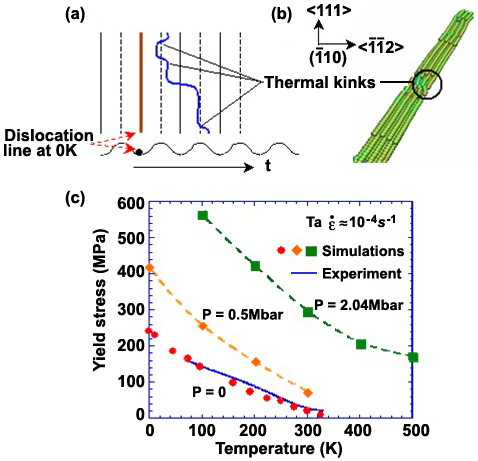Lin Yang, Per Söderlind, and John Moriarty
Methods: FP-LMTO, Planewave Pseudopotential, MGPT, Atomistic Simulation, Green's Function
The predictive multiscale modeling of plasticity, strength and other mechanical properties requires an accurate atomistic description of defect properties as input into higher length-scale simulations. Our goal is to use advanced electronic-structure (FP-LMTO, planewave pseudopotential, PP) and quantum-based interatomic-potential (MGPT) methods to calculate the atomic structure, energetics, and interactions of both point and extended defects in transition and actinide metals, including vacancies, interstitials, generalized stacking-fault or g energy surfaces, grain boundaries, and dislocations. Our recent emphasis has been on bcc transition metals (e.g., Ta, Mo) where robust MGPT potentials have been combined with accurate Green's function simulation techniques to the treat the properties of individual dislocations at both ambient and extreme pressure conditions. We have thereby developed a first-generation dislocation mobility model for bcc metals based on a thermal kink-pair nucleation mechanism and have input this atomistic information into 3D dislocation-dynamics (DD) simulations of the yield stress carried out at the microscale (see figure). Our current focus is on developing a next-generation mobility model for high-strain rates based on dynamic atomistic simulation results extending to the phonon-drag regime.
Selected Publications
- L. H. Yang, M. Tang, and J. A. Moriarty, "Dislocations in bcc Transition Metals at High Pressure," in Dislocations in Solids, Volume 16, Edited by J. P. Hirth and L. Kubin (Elsevier, The Netherlands: North-Holland, 2010), pp. 1-46.
- J. A. Moriarty, L. X. Benedict, J. N. Glosli, R. Q. Hood, D. A. Orlikowski, M. V. Patel, P. Söderlind, F. H. Streitz, M. Tang and L. H. Yang, "Robust Quantum-Based Interatomic Potentials for Multiscale Modeling in Transition Metals ," J. Mater. Res. 21, 563 (2006).
- J. A. Moriarty, V. Vitek, V. V. Bulatov, and S. Yip, " Atomistic Simulations of Dislocations and Defects ," J. Computer-Aided Mater. Design 9, 99 (2002) and references therein.
- L. H. Yang, P. Söderlind, and J. A. Moriarty, "Accurate Atomistic Simulation of (a/2) <111> Screw Dislocations and Other Defects in bcc Tantalum ", Philos. Mag. A 81, 1355 (2001).
Maintained by metals-alloys-web [at] llnl.gov (Lorin X. Benedict)





